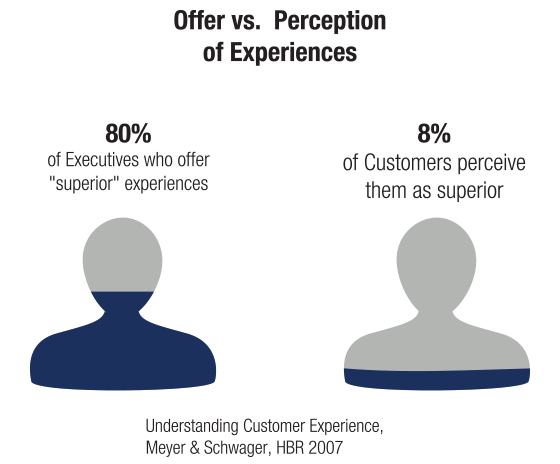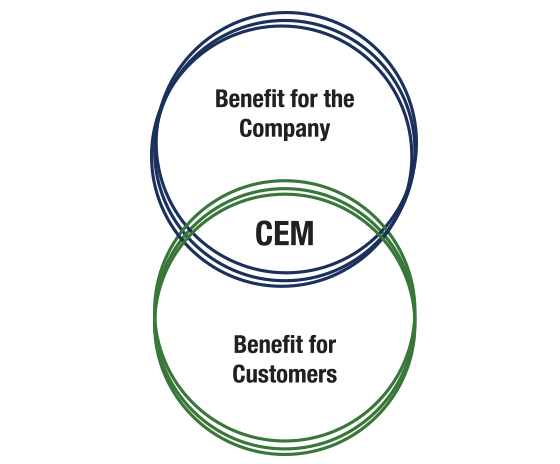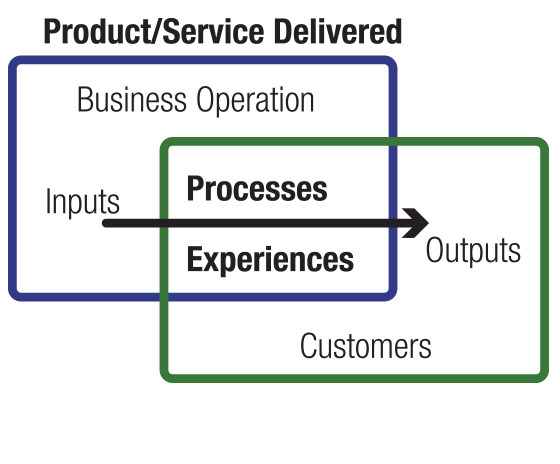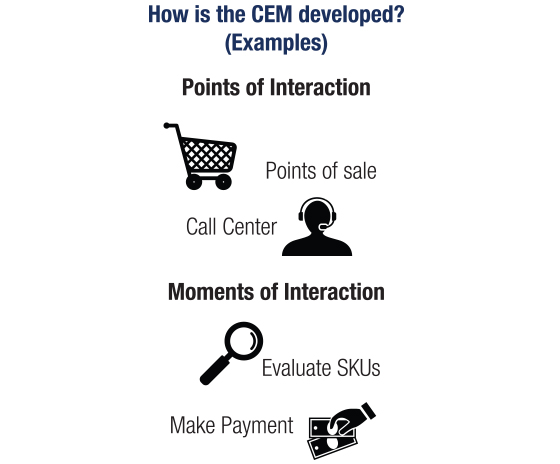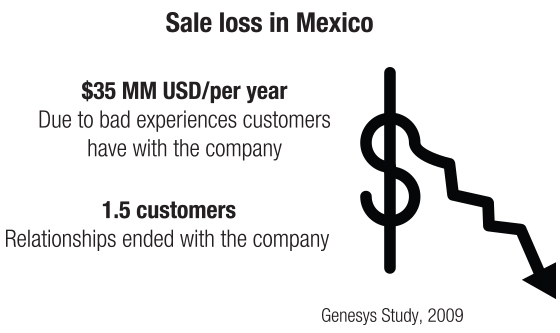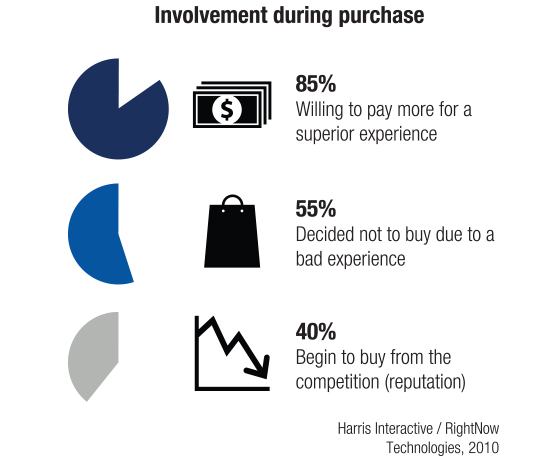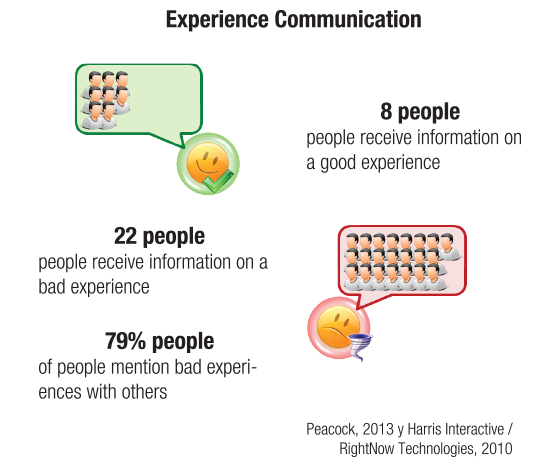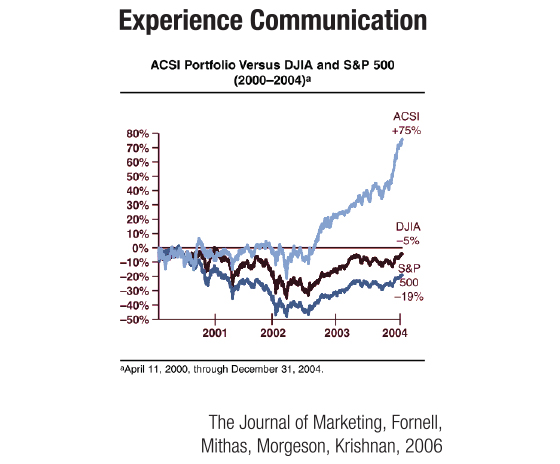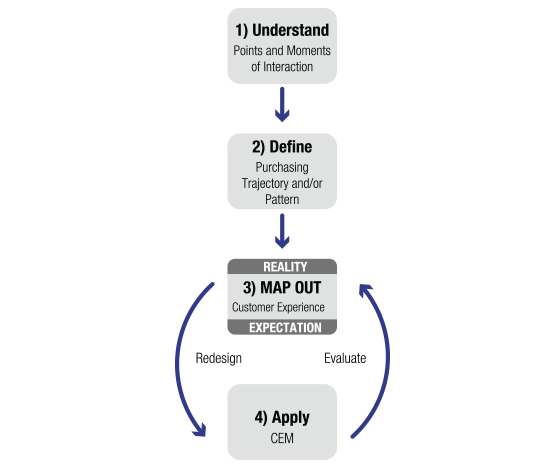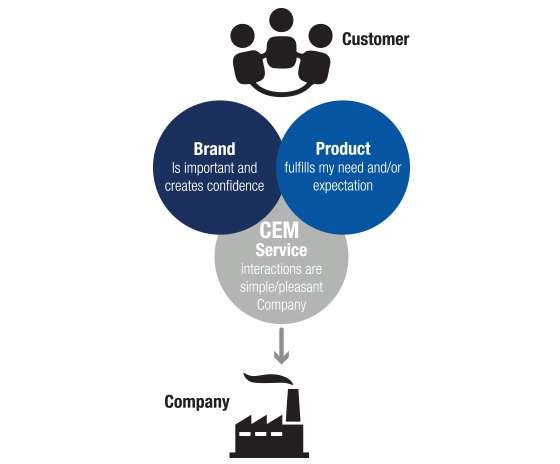THE CHALLENGE
The main objective of any business is profitable growth through customer satisfaction. Satisfaction is in essence the culmination of a series of pleasant experiences that customers have with the company, and although it is essential to measure it, the results don’t indicate how to obtain it.
Satisfaction is in essence the culmination of a series of pleasant experiences that customers have with the company.
A large number of customers who have already decided to buy, refrain from doing so due to a bad experience during the acquisition process. Most of them are left with such a poor impression of the company that they prefer to go with the competition. These experiences create negative emotions and feelings. Recent research on topics of buyer behavior have concluded that customers make decisions based on their emotions and later justify them with their rationale. These considerations have made customer experiences become the center of attention for companies.
In an article published by the Harvard Business Review (HBR), 80% of executives said that their companies provided “superior” experiences. However, only 8% of their customers perceived the experiences in that manner. Executives want to differentiate their value propositions from the competition, but most don’t know how to do so. What is the main obstacle? The lack of a clear strategy and processes focused on improving valuable experiences for customers.
Consumer companies have traditionally focused on understanding customers/end users to incorporate their knowledge or insight into their products/services. Companies are looking to improve product attributes and differentiate them from the competition to attract more preference among consumers and market share. Companies are also seeking to reduce production, distribution and marketing costs of their products by promoting them using mass media and/or strategies to drive more sales.
Advances in technology give customers more access to information and a number of similar offers available on the market, shifting the balance of decision-making power. Companies must obtain consumer insights when they are in buyer or shopper mode so as to understand their behavior and how they are influenced at every point in the purchasing process.
Companies must obtain consumer insights when they are in buyer or shopper mode so as to understand their behavior and how they are influenced at every point in the purchasing process.
Companies that are focused on shoppers integrate and align this knowledge throughout all their commercial, operating and engagement processes, as well as in all their corporate hierarchy: from the strategic decision-making level to the operations-task executor level that is in direct contact with the products that consumers are acquiring. Understanding the shopper, creating experiences and earning their satisfaction is an effort for the entire organization.
CEM – CUSTOMER EXPERIENCE MANAGEMENT
The customer experience involves an entire scientific and holistic process by nature, and includes the cognitive, affective, emotional, social and physical responses of a customer toward the company.
The experience depends on each event that a customer experiences as a whole — in the search, selection, purchase, consumption and post-purchase stages of a product across all the sales channels. It’s the synergy resulting from customers’ interactions with the company at all points of contact, including employees, channels, systems, products and services, as well as the perceptions of the brands emerging from such interactions.
Customer Experience Management or CEM involves a change of perspective of the business by offering the only relevant point of view: the customer’s. It requires understanding of the operation as the customers see it, where the business processes are important only to the point in which they are able to improve their experiences.
Converting customers into the center of attention allows companies to incorporate into their business strategies the insights that maximize benefits, both for the company and for customers, and to thereby enable a win-win situation for everyone. CEM involves the business strategy, integration of technology, orchestration of operating models, brand strategy, and the CEO’s commitment.
HOW AND WHERE DO EXPERIENCES TAKE PLACE?
The starting point for any organization that’s seeking to improve customer experience is based on the understanding and development of points and moments of interaction of its customers.
Points of Interaction
The means in which customers are in direct contact with an organization. They include: points of sale, shopping centers, call centers, websites, etc.
Moments of Interaction
The specific events that occur during a customer’s contact at some point of the process. For example: when speaking about a point of sale, it includes identifying the place, evaluating the product supply, choosing the desired item, making the payment, etc. For call centers, this includes: the waiting time to attend the call, the tone/attention of the operator, the options menu used for solving the problem, the answer to the customer’s request, etc.
CEM seeks to improve and develop these points and moments of interaction to design a unique and appropriate experience for customers. The more an organization understands how, where and why these interactions occur, the better it will adapt and design customer experiences with the products/services that are offered.
THE VOICE OF THE CUSTOMER
To understand and develop successful customer experiences, the most effective mechanism is the Voice of Customer (VoC). VoC allows a company to directly understand the points and moments of interaction from the customer’s point of view. In this way, the company can clearly incorporate the needs and preferences of the buyer into the business strategy.
“The aim of marketing is to know and understand the customer so well the product or service fits him and sells itself” — Peter Drucker.
The purpose of VoC is to understand who the customers are, how they are different among each other, what their perception of the brand is and involvement with the product or service and how they behave. To achieve this, the Voice of Customer includes different types of variables in order to characterize it:
Demographics – age, gender, occupation, income, education, geographic location, etc.
Psychographic– social class, attitudes, lifestyle, personality, etc.
Relationship with the brand – use status, knowledge of brand, consumption frequency, attitude toward the product, desired benefit, etc.
Behaviors – on purchasing, purchasing missions, transactions, usage, complaints, etc.
Experiences must be designed with a focus on what truly matters to the buyer, not on what the organization believes or assumes.
With a deep knowledge of buyers, companies can design experiences at each point and moment of interaction, with a focus on what truly matters to the buyer, not on what the organization believes or assumes.
IMPORTANCE AND BENEFITS OF CEM FOR THE COMPANY
Companies that incur in CEM development have achieved major benefits that exceed the benefits of improving customer satisfaction.
The emotional ties that are forged with customers translate into substantial sales increases over time.
Increased Income
The main benefit of CEM for companies is the increase in income that is sustainable in the long term. The emotional ties that are forged with customers translate into substantial sales increases, not only in the amount spent per unit, but also in the participation of customer and market portfolios over time.
Greater Customer Retention
By understanding and better serving current customers, they’ll stay with the company longer, which in turn means a cost reduction. According to a study by the Genesys company, the sale value lost in Mexico due to bad customer experiences totals US$35 billion per year. For an organization, this means on average 1.5 relationships ended with their customers.
It’s less likely that satisfied customers go with the competition for better prices.
Less Price Elasticity
One obtains a solid customer base that’s more tolerant and less sensitive to price changes. They are less vulnerable to persuasions and/or actions by the competition, so it’s less likely that satisfied customers go with the competition for better prices.
Better Margins
Customers are happy to pay a Premium for a product that they could acquire elsewhere for a lower price; they’re not only paying for the product, but also for a fulfilling experience. According to results from Harris Interactive / RightNow Technologies, 85% of customers are willing to pay more for a superior experience during their purchasing behavior with a product and/or service.
Competitive Advantage
The ability to create and deliver unique and unforgettable experiences leads to a competitive advantage over the competitors — more so than offering products and services that stand out on the market.
Market intelligence helps to align the company’s strategy, taking into account the Voice of Customer and adapting it to the business objectives.
Market Intelligence
When considering customers as the center of attention, it’s easier to get their feedback. The comments, observations, complaints or complements must be translated by organizations into market intelligence, as it represents the most effective form to align the company’s strategy, taking into account the Voice of Customer and adapting it to the business objectives. The company’s role and relevance in this lies in establishing the institutional means to collect customer feedback and translate it into market intelligence for decision-making.
Better Word of Mouth Publicity
By nature, people transmit their experiences to family and friends, and on occasions this may be more rapid than any communications or marketing campaign by a company. According to a study by Wayne Peacock and Harris Interactive / RightNow Technologies, a good experience is commented to 8 people on average, but when a customer has a bad experience, he or she shares it with 22 people. In other words, a bad experience is communicated 2.8 times more than a bad one.
Increase in Future Cash Flows
Customers are the principal source of all future cash flows, and their satisfaction is a significant indicator of the solidity of a business in terms of the company’s relationship with its customers. In a sample of more than 200 Fortune 500 companies, an increase of 1 percentage point on the American Customer Satisfaction Index (ACSI) represents an increase of an additional US$55 million in net operational cash flow for the following year.
More Value of the Action
Companies with better performance in ACSI satisfaction indicators generate better financial returns with a lower systematic risk than the rest of the market. According to a study by The Journal of Marketing, a selected portfolio with the best 20% of companies according to ASCI has better financial performance than other indices on the market, such as DJIA, S&P500, and NASDAQ.
EXPERIENCE REDESIGN
Given the importance of CEM in organizations and the tangible benefit that translates into business results, the redesign of experiences scales as a relevant topic in the CEO’s agenda.
1) The redesign of experiences begins with an exhaustive understanding of all the points and moments of interaction from the point of view, perception, and empirical evidence of the customer.
2) The customer’s buying trajectory and/or pattern is then identified, identifying the possible variants that exist in their interactions. These insightscan be collected from focus groups, surveys, questionnaires or interviews.
3)Afterwards, the customer’s actual experiences are mapped based on the purchasing trajectories and/or patterns, detailing the customer behaviors, actions, obstacles, thoughts, and motivators in each interaction.
The real vs. expected experience by the customer is evaluated, identifying opportunities where the most value in the interaction is created. By having these insights, one can identify the points and moments of interaction subject to a redesign to improve the experience.
4) The result is a map of experiences that’s aligned with the expected interactions and which generate value for the customer. The redesign of interactions, their measurement, and feedback is a process subject to continuous improvement within the organization.
CONCLUSIONS
The objective to be recognized and the preference of the whole organization is having loyal customers who, in addition to buying the product, defend and advocate the company’s brand. This result is possible only by strengthening the business ties and satisfaction through unforgettable experiences.
Through CEM, business ties and satisfaction are strengthened through unforgettable experiences/ development of unforgettable experiences for the customer.
By considering loyal customers who are willing to make an economic or personal sacrifice in order to strengthen a relationship (Reichheld, 2001), creating positive experiences fosters brand promoters — Net Promoter. It increases customer retention and generates better income, which in turn creates value for everyone.
Organizations that concentrate on developing unique experiences by focusing on and understanding customer insights will find that that is the form in which they will truly achieve a competitive advantage over the rest of the players.
CEM involves a radical change of business perspective: the customer’s point of view. CEM involves the business strategy, integration of technology, creation of operating models, brand strategy, and the CEO’s commitment. It requires seeing the operation as the customers see it, where the business processes are important to the extent that they are able to improve their experiences. Companies that focus on and use CEM will obtain major tangible benefits for all stakeholders.
